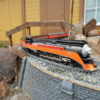In an effort to put a positive "spin" on this, I considered what is the minimum it would require to make a 2-rail O scale (vs 3-rail O scale) decision "early" in the decision process. The biggest hurdle is the internet interest by young people, and this is a big hurdle, for which I have no response.
I think that the following, as a minimum, are requirements to attract those who might CONSIDER 2-rail (vs 3-rail): (If space is TRULY an issue, I have no answer except O gauge/scale has a basic inability to compete with HO if limited space is the criteria.)
MAKE THE COST OF ENTRY INTO 2 RAIL AS LOW AS POSSIBLE, PREFERABLY LOWER THAN 3-RAIL AND NO MORE THAN THE COST OF A LIONEL STARTER SET. (The reality is that this will probably not increase market size significantly, but sustain the existing O market.)
-inexpensive two rail track, certainly no more expensive than 3-rail O gauge track, and preferably, with only two rails, less expensive. The sharpest curvature (48 radius?), pre curved 2-rail track that will permit operation of a small four axle locomotive. A small circle or a rounded "square" that could include straight track and that would be large enough to surround a Christmas tree would be ideal. This should be as least expensive as possible, a loss leader, perhaps at a price of $48-$64, that would be 12-16 pieces at $4/piece.
-an inexpensive DC power supply, at a price point of $75?
-a #5 hand thrown, non motorized switch for less than $40, assuming many modelers will want two for a siding. (Limited low cost or unavailable switch offerings have been a perennial complaint in the 2-rail market. This would come later.)
-Full O scale rolling stock offerings less trucks, but ALL with coupler pads for installation of Kadees or similar, and priced at no more than $30. (NO 6464 size boxcars or other here.) USE ALREADY EXISTING TOOLING TO REDUCE ENTRY LEVEL COST!
-A choice of 2-rail or 3-rail trucks for a much lower cost than $25/pair, perhaps $15. Even more cost effective is a standard truck with the ability to just change wheelsets. Plastic wheels minimally acceptable but metal (insulated one side) preferred since metal is common to Lionel, etc. Bulk discounts on 2-rail metal wheelsets vs one car set of four wheel and axle assemblies. (All rolling stock to enable the installation of EITHER 2-rail or 3-rail trucks, with a screwdriver.) USE ALREADY EXISTING TOOLING TO REDUCE ENTRY LEVEL COST!
-A short, small, but prototypically sized diesel switcher, EMD SW or Alco S type, with 2 can motors, that will operate on 12 vdc with a plug (like HO) that would permit later addition of DCC. Metal axles and gearing and with the ability to replace 3-axle wheel sets with 2-rail wheel sets at a nominal cost, say $200. USE ALREADY EXISTING TOOLING TO REDUCE ENTRY LEVEL COST!
The main point with all of the above is to make the initial "buy in price" as low as possible.
If O gauge/O Scale model railroading is to grow, the few importers that exist will be required to deviate from a "harvest pricing" mode. I am a TCA member and remember that TCA members were quite recently over 30,000. The TCA magazine no longer publishes membership numbers, but based on the qty of magazines in a print run, TCA memberships have dropped by about 40 percent. (The 12/2021 issue contains the number of copies printed closest to the filing date. That number is 18,580.) Based on age demographics, I also believe that Lionel partisans and collectors are declining. It's up to Lionel and Atlas to deviate from their existing modus operandi and try something different and innovative to sustain and then grow this market. If they do not, the next step for the investment firm that owns Lionel will be to divest itself from its investment. One problem I see with this recommendation is that it may already be too late. An interesting statistic would be how many Lionel modelers are buying new Lionel vs buying in the used/old market. If the O importers select the most appealing products and price them as above, the decision to buy new vs. paying for used/old/broken as the only option at sporadic train meets would be clear.
Regarding sales channel, the only thing that makes sense in a tight price market is to sell only direct via the internet. (I am not against and certainly support hobby shops. The problem is that there will not be sufficient "dollars" to maintain an importer and a hobby shop (ie a reseller)). The internet is the only sales channel that young people consistently use.
My OPINION.
-
-






